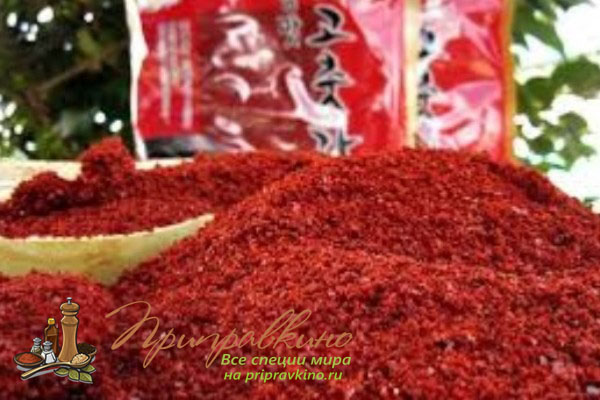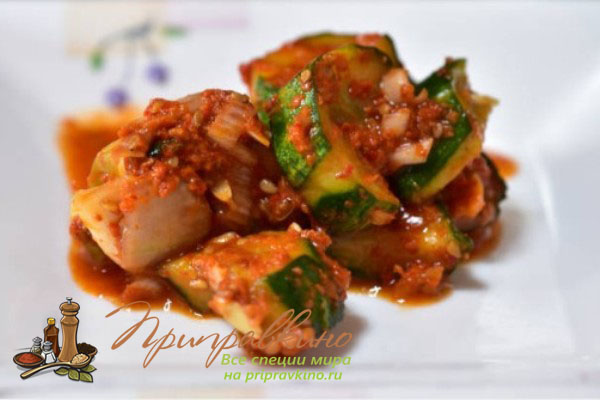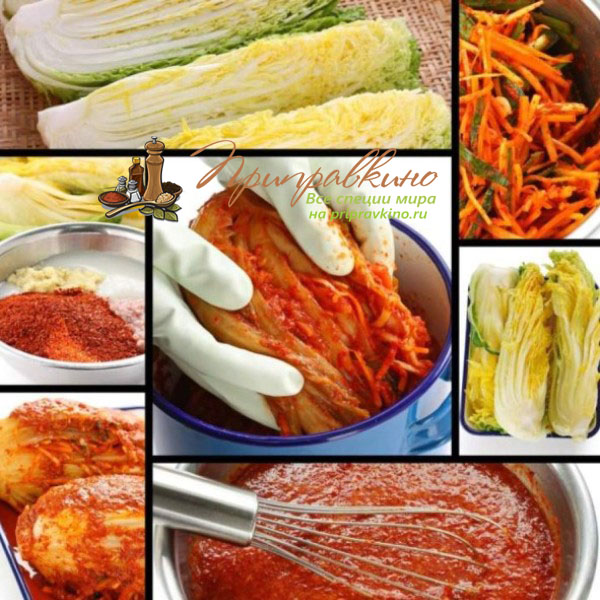A healthy recipe in Korean: what is kimchi sauce, how it is prepared and what it is eaten with
01.09.2018
If you have never heard of kimchi, then you should get acquainted with this amazingly delicious product. This is a spicy, incredibly invigorating combination of red pepper flakes, garlic, ginger, sugar, lime juice, water, salt and fish sauce. The amazing kimchi, whose taste is admired all over the world, has been researched for both health benefits and harms.
What is kimchi?
Kimchi is the common name for fermented (sour) vegetables that range from cucumbers and chili peppers to mustard leaves, but the most famous variant contains cabbage seasoned with garlic, ginger, green onions, chili peppers (kochukaru) and fish sauce. .
The same process is used to prepare this dish as for the production of sauerkraut or pickles. Bacteria that are released during fermentation (fermentation) preserve kimchi for a long time and give it a unique flavor.
This is the national dish of Korea, which has become popular in many countries around the world. There are about 200 varieties of it made from different vegetables. Salty and usually moderately spicy kimchi comes in a huge variety, both as pickled vegetables and as a special sauce.
Kimchi sauce is a mixture of red pepper flakes, garlic, ginger, sugar, lime juice, water, salt, and fish sauce. It is quite versatile - it is used with all kinds of dishes. The spicy and delicious notes of kimchi pair with just about anything.
 What does kimchi sauce look like?
What does kimchi sauce look like?
Ingredients of kimchi sauce
Fragrant, simple, authentic, healthy kimchi sauce can be made by hand in any kitchen by gathering all the ingredients that make up its composition.
Red pepper for kimchi "Kochukaru"
Kochukaru is a Korean term for red pepper flakes. The traditional form of this spice consists of sun-dried red chili peppers that have been roughly ground. The final texture is somewhere between regular pepper flakes and fine powders like cayenne pepper or paprika.
Cochucaru is tangy and sweet with smoky notes, but not as hot as many of the Latin American chili varieties. The spiciness level of kochukaru varies and ranges from approximately 1,500 to 10,000 on the Scoville scale.
 Kochukaru is a Korean red pepper flake that is the main ingredient in kimchi sauce.
Kochukaru is a Korean red pepper flake that is the main ingredient in kimchi sauce.
Some fans of Korean food believe that there is nothing that can replace kochukara. However, there are adequate alternatives that you will certainly need if you live in an area without a specialty grocery store.
- A replacement for a kochukaru can be a regular red ground pepper: It has the same bright color and moderately strong spicy aroma. It is easy to find and sold in many local shops. However, it is spicier than the original ingredient and often contains seeds that concentrate most of the heat. As a result, when using ground red pepper to replace koçukara, beware of spiciness: its amount should not exceed two teaspoons.
- Another replacement option is chipotle, which is made by drying and smoking ripe red jalapeno peppers, which is described in. It has some smokyness (but much more than kochakura) and the overall level of spiciness is quite comparable. For a substitute, mix some chipotle powder with ground red pepper for a more balanced flavor. Yes, you will increase the pungent taste a bit, but get closer to the flavor of kochakuru (albeit without a hint of sweetness).
fish sauce
Spices
And finally, most kimchi recipes call for a spice mix: pepper flakes with ginger and garlic. Garlic is one of the strong ingredients, and its flavor intensifies during fermentation, resulting in a deep, heady aroma.
In addition to these three basics, there are many variations. For the most part, the main vegetables in kimchi are Beijing or Chinese (also called Napa) cabbage. Green onions, daikon radish and carrots are also added to it. Many recipes include dozens of different types of vegetables and even fruits.

What smells and what kimchi sauce tastes like
The taste of kimchi is complex and varies depending on the recipe. The main aromatic notes include sour, spicy and umami. The smell will also vary depending on the length of fermentation and the amount of salt or sugar.
Kimchi is a fermented dish, so it has a pronounced sour taste. The lactic acid produced by the bacteria during the fermentation process also imparts a pungent flavor.
Depending on how much red pepper is used, kimchi sauce can taste either light or very spicy.
How to choose and where to buy kimchi sauce
The popularity of kimchi has been steadily growing around the world, and it can now be found in many grocery stores in major cities. Look for it in the chilled pickles and sauerkraut section.
Choose brands that do not pasteurize this product, as the pasteurization process destroys the beneficial bacteria population. Also, the composition should not contain artificial preservatives, dyes and flavors.
The easiest way to purchase kimchi sauce is to order with delivery in specialized online stores.
Kimchi is also available in Asian markets, Korean cafes and restaurants, and sushi bars.
How to cook kimchi - a simple Korean cabbage recipe
In the old way of cooking, kimchi was kept cool underground in jars, and with the development of technology, special refrigerators began to be produced for this.
Cooking at home is quite simple, but takes a little time, as it will take several days to ferment. This easy step by step Korean cabbage recipe is a great starting point if you are making kimchi for the first time as it is very close to the original.
Ingredients for preparing 1 liter of kimchi cabbage:
- 1 medium Beijing cabbage (about 1 kg);
- ¼ cup sea salt;
- 1 tablespoon minced garlic (5-6 cloves)
- 1 teaspoon grated fresh ginger root;
- 1 tsp Sahara;
- 2 tbsp. l. fish sauce;
- 1-5 art. l. red pepper kochukaru;
- 200 g daikon, peeled and cut into thin strips;
- medium-sized onion, chopped into half rings.
Cooking method:
- Cut the head of cabbage lengthwise into 4 pieces. Cut off the stalks. Cut each quarter into 5cm strips.
- Place cabbage in a large bowl and sprinkle with salt. Rub it with your hands until it starts to soften a little. Add enough water to cover the cabbage. Press it down with a plate and weight it down with a jar of water or beans. Let stand 1-2 hours.
- Drain liquid from cabbage. Rinse it under cold water 3 times. Drain through a colander and let the liquid drain for 15-20 minutes.
- Meanwhile, make the kimchi dressing. Mix garlic, ginger, sugar, and fish sauce in a separate bowl until smooth. Add red pepper, using 1 tablespoon for a mild flavor, up to 5 for a spicy one.
- Gently squeeze the remaining water out of the cabbage and combine it with the spicy paste. Add daikon and onion. Mix thoroughly.
- Pack the kimchi tightly into a one-litre jar and tamp until the brine is released, covering the top of the vegetables. Close the lid.

Place the jar in a cool place out of direct sunlight for 1 to 5 days.
When the kimchi is ripe (you can tell by tasting it), move the jar to the refrigerator. You can eat it immediately, but it is best after a week or two.
How to make kimchi in Korean - video

How and how long to store kimchi
Even fermented foods can go bad over time, and kimchi storage temperature has a huge impact on fermentation rate, taste, and shelf life.
Fermentation slows down with cooling and accelerates with increasing ambient temperature.
Kimchi can be stored for several months in the refrigerator, but is best used within a week of opening.
Chemical composition
Kimchi is a low-calorie food (only 34 calories per 100 grams), high in fiber and a nutrient-dense side dish.
This is a storehouse of a number of vitamins - A, B1, B2, B6, E, K and C.
Kimchi is also rich in essential amino acids and minerals such as iron, calcium, and selenium.
It has an impressive range of powerful antioxidants and probiotics in the form of lactobacilli.
Kimchi contains many beneficial compounds, including capsaicin, chlorophyll, carotenoids, flavonoids and isothiocyanates, and small amounts of fat and sugar.
Nutritional value of kimchi per 100g
| Name | Quantity | Percentage of the daily norm,% |
|---|---|---|
| Energy value (calorie content) | 34 kcal | |
| Carbohydrates | 7 g | |
| Protein | 1.1 g | 2 |
| Dietary fiber (fiber) | 0.8 g | 3 |
| folate | 29.5 mcg | 7 |
| Niacin | 0.600 mg | 3 |
| Pantothenic acid | 0.100 mg | 1 |
| Pyridoxine | 0.100 mg | 5 |
| Riboflavin | 0.025 mg | 2 |
| Thiamine | 0.036 mg | 3 |
| Vitamin A | 805 IU | 16 |
| Vitamin C | 4.4 mg | 7 |
| Vitamin K | 7.5 mcg | 9 |
| Sodium | 781 mg | 33 |
| Potassium | 84.2 mg | 2 |
| Calcium | 22.2 mg | 2 |
| Copper | 0.1 mg | 3 |
| Iron | 0.7 mg | 4 |
| Magnesium | 12.4 mg | 3 |
| Phosphorus | 20,1 | 2 |
| Selenium | 1.4 mcg | 2 |
| Manganese | 0.2 mg | 9 |
| Zinc | 0.20 mg | 1 |
health benefits of kimchi
Kimchi has many health benefits due to the nutrients it contains. More and more people are eating it for its taste and health benefits.
Not only does this Korean dish offer an abundance of fiber and nutrients, it also contains beneficial bacteria that fight infections and have been shown to boost immunity. Since the vegetables in kimchi are fermented (fermented), they have excellent probiotic properties.
Regular consumption of kimchi will help prevent health problems, namely:
- Helps with digestion. The fermentation process not only enhances the taste, but also creates healthy Lactobacillus bacteria, which the body needs to maintain a healthy intestinal flora. The fiber present in kimchi also helps in stabilizing bowel movements and prevents constipation.
- Regulates cholesterol. Garlic, which is used to make kimchi, is rich in selenium and allicin. Allicin is a component that helps lower cholesterol levels, thereby reducing the risk of developing cardiovascular disease. Selenium also has a protective effect on artery walls, preventing plaque formation and reducing the risk of atherosclerosis. Kimchi reduces total and "bad" cholesterol along with the concentration of glucose in the body.
- Antioxidant Properties. The antioxidants in kimchi along with the phenols and flavonoids present in it have a protective effect against oxidative damage and protect the body from the harmful effects of oxygen free radicals.
- Treats atopic dermatitis. The presence of lactobacilli in kimchi makes it a versatile condiment. It has a therapeutic effect on various skin diseases, such as atopic dermatitis, which is characterized by elevated levels of immunoglobulin E and skin lesions in the form of edema and hemorrhage.
- Promotes weight loss. Lactobacilli also aid in weight loss by controlling appetite and reducing blood sugar levels. The fiber in kimchi makes you feel full faster and keeps hunger at bay for longer, so you don't overeat.
- Increases immunity. Multi-component kimchi, rich in nutrients, contains various flavonoids and phenolic components. The variety of ingredients including ginger, garlic and pepper involved in cooking are super-protectors that are renowned for their beneficial effects on the immune system. They help fight infections and are valuable in treating cold and flu symptoms.
- Anti-aging properties. Kimchi is helpful in regulating and easing inflammation, which accelerates the aging process. Research has also shown promising results for factors such as reducing oxidative stress in cells, inhibiting lipid peroxidation, and increasing lifespan in subjects, making kimchi a powerful anti-aging ingredient.
- Prevents cancer. Cabbage present in kimchi contains beneficial flavonoids, which are believed to inhibit the growth of cancer cells. Other powerful cancer fighters are glucosinolates found in cruciferous vegetables (cabbage). Glucosinolates break down to form isothiocyanates, which are well known for their effectiveness against the growth of malignant tumors. Capsaicin is the substance that gives red peppers their pungency. It is also effective in preventing the spread of prostate cancer cells. Studies have shown that capsaicin causes prostate cancer cells to destroy themselves.
- Treats diabetes. In a study conducted on type 2 diabetics, the anti-diabetic properties of this Korean delicacy were revealed. The study showed better glucose tolerance and lower fasting glucose levels after eating kimchi.
- Reduces stomach ulcers. Kimchi has a therapeutic effect in gastritis and peptic ulcer disease caused by the bacteria Helicobacter pylori (Helicobacter pylori). Research conducted in this field has shown that antagonistic activity is due to the abundance of Lactobacillus bacteria, which prevent harmful pathogens from entering human stomach cells.
Contraindications (harm) and side effects of kimchi
In order to get only the benefits of kimchi, it is advisable to start by adding a small amount to the diet so as not to cause harm to health due to possible side effects.
Kimchi is high in fiber, which can cause problems with gas and bloating in susceptible individuals.
People suffering from high blood pressure should be careful when eating kimchi due to the high salt concentration, which is further aggravated during the fermentation process.
Excess consumption of this dish can lead to digestive problems and even exacerbate the risk of stomach cancer.
This does not mean that kimchi is unhealthy food, on the contrary, it is healthy, but there are risk factors in excess quantities.
What is kimchi sauce eaten with - culinary uses
Korean cuisine offers a wide variety of dishes that include kimchi sauce, including soups, stews, noodles, and spicy pancakes.
This is a great side dish or appetizer. It can also be added to soups, stews or rice dishes. Kimchi is deliciously good, even in sandwiches or burgers.
Here are some of the uses for kimchi sauce in cooking:
- It is used to flavor fried rice, noodles, sandwiches and even pizza.
- It is mixed with vegetables as a condiment.
- Try making the popular Korean kimchi dumplings (kimchi mandu): combine the sauce with minced pork or beef and wrap it in the dough. You can fry or steam them however you like!
- Fried eggs with ham and kimchi sauce is perfect for breakfast.
- Fried kimchi tofu (dubu kimchi) is a popular snack in Korea. It is also a very good side dish for main dishes. The spicy smell of kimchi, pork and the nutty flavor of sesame oil are amazing!
More and more people outside of Asian countries are beginning to realize that in addition to the excellent and exotic taste of kimchi, this spicy dish has a long list of health benefits.
